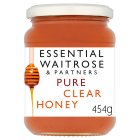

Get ready to elevate your grill game with spiced burgers, charred vegetables and fall-off-the-bone fish. Our essential barbecue guide is packed with expert tips, tried-and-tested techniques and garden-ready recipes to help you serve up something special this summer. Fire it up!
Watch: How to cook lamb skewers like a pro
Everyone loves a kebab, right? Waitrose chef Alex Szrok fires up the barbecue to grill tender lamb steaks, finished with a punchy herb and anchovy sauce.
See & shop the recipe


Barbecue cooking tips
- Take meat out of the fridge 30 minutes before cooking to help it cook more evenly.
- Rest meat for 10-15 minutes after barbecuing to allow the juices to redistribute.
- Go easy on sweet ingredients such as honey in marinades – they can make the food burn.
- Buy a food thermometer to give you confidence that everything is cooked through.
- Become a kebab master by keeping all the pieces the same size so they cook evenly.
- Cook meat low and slow first for tenderness, then sear hot at the end for flavour and crust.
Now cooking on gas (and charcoal)
Times and temperatures for every occasion.

How to cook on a gas barbecue
Preheat with the burners set high for 10 minutes, until hot.
Turn one burner to medium and leave one at high.
If your gas barbecue doesn’t have a cooling shelf, turn one burner off once preheated to create a cooler zone.

How to cook on a charcoal barbecue
Light 15-20 minutes before cooking.
Wait until the coals turn ash-grey and are glowing. You can start earlier with the lid on if you’re slow-cooking.
Using tongs, bank the coals to one side and open any vents at the base of the barbecue.
Yes, chef!
From meat and fish to fruit and veg, consider this your barbecue masterclass.

How to cook meat
Always bring your meat to room temperature for even cooking.
Oil the meat, not the grill, to prevent sticking.
Use direct heat for cuts that cook quickly and indirect for those that need time.
Turn meat only once or twice to avoid losing juices. Always rest it.

How to cook fish
Choose meaty fish to barbecue directly and delicate fish to wrap in foil.
Leave the skin on for protection and flavour.
Cook fish skin-side down first to hold it together; flip once.
Assess doneness – the fish is cooked through when it flakes with a fork.

How to cook fruit & vegetables
Fruit and veg, such as pineapple and cauliflower, are brilliant on the barbecue.
Cut into uniform pieces so everything cooks at the same rate.
Use direct heat for quick-cooking ingredients and indirect heat for denser produce that needs a little longer.
Avoid overcooking so veg still has bite and fruit doesn’t collapse.

Barbecue cooking times for gas and coal
Barbecue sides and sauces

Superstar sides
Sides don’t have to be sideshows: think of a winning potato salad – the spuds baked at the edge of the barbecue as the coals heat up – or whole baked beetroots (wrapped in foil then slow-cooked). Don’t forget your condiments: ketchup, BBQ sauce, mustard, garlic mayo and sriracha always go down a storm.

Marinade masterclass
From a hot sauce to spice up chicken wings to a smoky butter to melt over steak, a marinade is the secret to enriching flavours and ensuring juiciness in every bite. Top tip: marinate your meat or fish while you’re waiting for the barbecue to heat up.
















